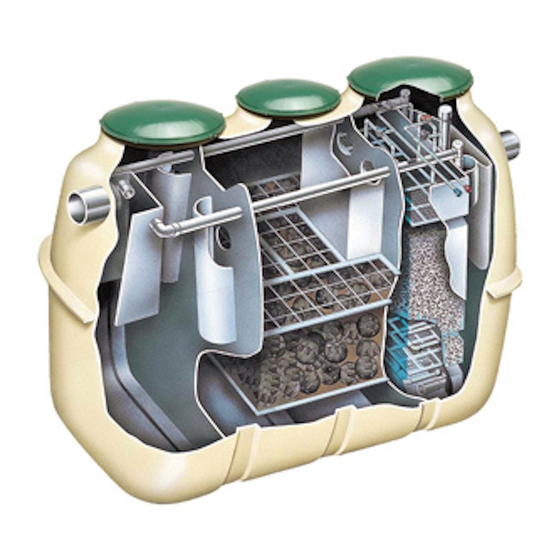Clarus Fusion Series Manuel du propriétaire - Page 16
Parcourez en ligne ou téléchargez le pdf Manuel du propriétaire pour {nom_de_la_catégorie} Clarus Fusion Series. Clarus Fusion Series 20 pages. Treatment systems
Également pour Clarus Fusion Series : Manuel du propriétaire (20 pages)

Inspect the alarm panel for signs of water or odors inside. Toggle the
test switch on the side of the box to check that both the alarm horn and
the alarm beacon light are operational.
Inspect the blower for proper operation. If the blower is not functioning,
refer to the troubleshooting section near the end of this guide.
1.
Listen for loud rattling sounds. The blower should hum softly. If
a rattle is heard, ensure that all four legs securely contact the
ground or base medium.
1.
Odor
Offensive odors are often the result of insufficient or inappropriate
bacterial growth. Causes may include a young or unestablished
system, insufficient air introduction, or the addition of detrimental
chemicals or poisons into the system. Ensure the blower and
air delivery systems are functioning. Check with the owner
regarding chemical use and disinfection habits. Check all risers
and lids to ensure an airtight seal.
2.
Foam Formation
Foam formation is observed in the following situations:
1. In the early stage of operation when the
aerobic bacteria colony is establishing itself.
2. When an excess amount of air is supplied for aeration.
3. When the difference between ambient
temperature and water temperature is great.
4. When an excessive amount of detergent is
introduced.
In most cases, foam will disappear with proper operation.
When excessive amounts of detergent have been introduced
to the system, remind the owner to use appropriate amounts of
detergent.
3.
Cloudy Treated Water
• Check the amount of scum and sludge:
If too much scum or sludge is observed, transfer
them to the first chamber and adjust recirculation flow
rate as well as backwash time, frequency and duration.
(See backwash flow adjustment)
• Check the aeration situation:
If uneven bubble generation is observed, adjust
valve (1). If aeration is weak, flush the aeration
pipe with air or water.
• Check the recirculation flow rate:
If the recirculation flow rate has increased
after the last inspection, the aeration pipe may
ALARM PANEL & BLOWER INSPECTION AND MAINTENANCE
TROUBLESHOOTING
© Copyright 2014. All rights reserved.
2.
Inspect the filter once the power has been disconnected by
removing the filter retention screw. Then, remove the cover
by snapping the filter cover off the top of the blower. Clean
the filter by knocking the dust out or by rinsing with water
to remove accumulated particles. Be sure the filter is dry
before reinstalling.
be clogged. Flush the aeration pipe with air or
water. If the recirculation flow rate has decreased after
the last inspection, the airlift pump or recirculation
pipe may be clogged. Clean them with a brush and
running water.
• Check the color of the returning sludge from the
backwash pipe:
If the color is abnormally dark, decrease the
recirculation flow rate accordingly. If the TSS of
the water from Anaerobic to Aeration Chamber is
high, check the sludge accumulation. If the sludge
accumulation reaches the upper limit, pump out the
sludge. If not, backwashing the Anaerobic Chamber by
using a manual backwash tool (Figure 17) may assist.
4. Blower
Blower motor does not run, with power connected:
•
Check the electric supply to the panel, ensuring 120
volt service.
•
Check that all breakers and fuses in the panels are
on and intact.
•
Refer to instructions supplied with blower.
Little or No Aeration / Backwash Air:
•
Check the blower motor is running.
•
Check the air line piping connectons at the blower.
•
Check the air filter and clean or replace if necessary.
•
Check the diaphragms and replace if necessary.
•
Check the air piping for leaks, clogs, or dislocations and
correct accordingly.
•
Verify check valves (if installed) in supply lines are
installed correctly.
16
